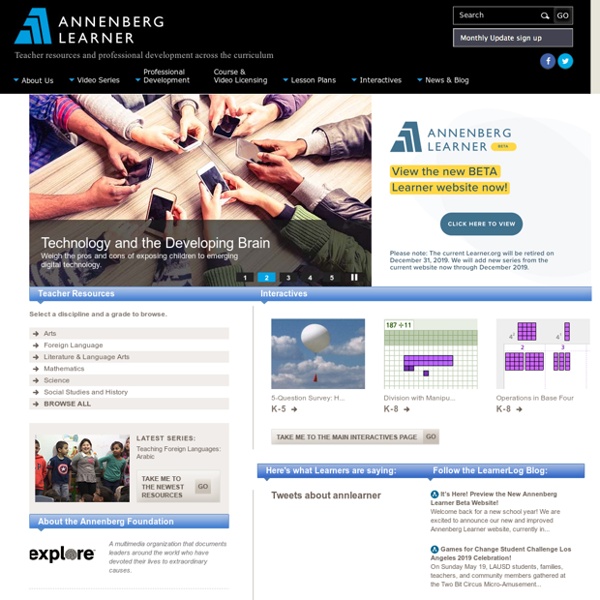



Marilyn Burns Math Blog Multiplication Bingo has long been one of my favorite games, and I recently introduced it to students who have been committing the multiplication facts to memory. (More about how the students are studying the multiplication facts appears at the end of the blog.) Also, several different versions of the game allow for varying and differentiating the experience, making it a good addition for the class Math Menu. First a Caveat about Understanding vs Memorization Years ago I had a conversation with Paul, a fourth grader. Teaching the Teachers: At a Glance With 46 states and the District of Columbia climbing on board, the looming Common Core State Standards are shaping up to be one of the largest educational reforms in recent history. The academic benchmarks for math and English Language Arts represent a retreat from the traditional rote, fact-based style of instruction toward teaching that fosters critical thinking and problem solving among students. But research shows that teaching for critical thought isn’t widespread in our classrooms (Nystrand and Gamoran, 1991; Nystrand et al., 1999; Kane and Stainger, 2012). Meeting the demands of the Common Core means teaching teachers new approaches to instruction; in other words, reform demands effective professional development. Recent education reforms have urged teachers to foster collaboration, debate and reflection among students, in order to develop cognitive processes like those called for in the new standards. Effective Professional Development
Area of a Circle Students use their knowledge of the relationship between the circumference and diameter of a circle to see why the area of a circle is πr2. Guiding questions encourage students to think about issues of accuracy and informally introduce the idea of the circle as a limiting shape. The lesson involves visualisation and explanation. This sequence is for students who: know basic properties of circles.know the formulas for the circumference of a circle and the area of a triangle.are familiar with π as the ratio of circumference to diameter of a circle. Reading Royalty: Analyzing Running Records - MSV Made Easy with a Freebie! Since mid-year benchmark testing is here, I thought it would be helpful to talk about getting the most information out of those running records as possible. Analyzing errors and self-corrections in running records can give you SO much information. This information can help you to determine what your students are using to decode words and what they need to work on. Take a running record of a student reading a passage or short text aloud.
Emma — EMMAths: Learning and Teaching Emma works in an FE/HE College in Northern Lincolnshire where she teaches maths and PGCE students. Previously, she worked in an Inner London Secondary, was Head of Maths at an 11-16 school in Grimsby and coordinated GCSE and Functional Skills maths at a sixth form college. Emma is a “credible specialist” for Pearson/Edexcel, specialising in Post-16 mathematics, delivering CPD across the country (and the world!). Oracy in the Classroom: Strategies for Effective Talk "What makes me enjoy talking the most," explains Milo, a Year 3 student, "is that everybody’s listened to you, and you’re part of the world, and you feel respected and important." Oracy -- the ability to speak well -- is a core pedagogy at School 21, a London-based public school. "Speaking is a huge priority," stresses Amy Gaunt, a Year 3 teacher. "It's one of the biggest indicators of success later in life. It's important in terms of their employability as they get older.
: 5 Maths Gems #112 Welcome to my 112th gems post. This is where I share some of the latest news, ideas and resources for maths teachers. 1. Out of This World Literacy : 9 Essential Questions When Planning For Guided Reading I've been asked so many times how to plan for guided reading. Teachers ask me: 1. Thinking Mathematically We learn better when we are curious, resourceful, resilient and collaborative. Here are some collections of mathematical activities designed to help you develop these characteristics. In this film (available here if you live outside the UK) the mathematician Andrew Wiles talks about his personal experience of seeking a proof of Fermat's Last Theorem. He describes what it is like to do mathematics, to be creative, to have difficulties, to make mistakes, to persevere, to make progress, to have a dream and love what you are doing so much that you are willing to devote yourself to it for a long time. Of course, each mathematician's experience is different, and most mathematicians do not work alone for such prolonged periods without discussing their work with others, but much of Andrew Wiles' experience is shared amongst mathematicians, and reminds us of the rewards of perseverance in the face of difficulty.
AZk12 - Professional Development for Educators What is the Arizona Technology Integration Matrix? The Technology Integration Matrix (TIM) illustrates how teachers can use technology to enhance learning for K-12 students. The TIM incorporates five interdependent characteristics of meaningful learning environments: active, collaborative, constructive, authentic, and goal directed (Jonassen, Howland, Moore, & Marra, 2003). The TIM associates five levels of technology integration (i.e., entry, adoption, adaptation, infusion, and transformation) with each of the five characteristics of meaningful learning environments.
How to Create 9 Identical Dot Patterns in 10 Seconds or Less - Steve Wyborney's Blog: I'm on a Learning Mission. More Free Animated Math Lessons Coming Soon! Subscribe to get the latest content by email. Success! Now check your email to confirm your subscription.